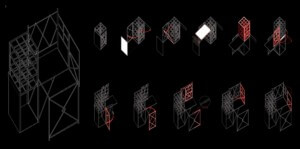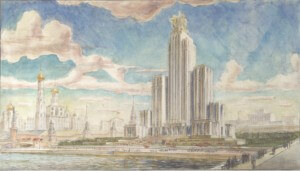October 25th, 2017 marks the 100th anniversary of the beginning of the October Revolution, when a group of socialist revolutionaries stormed the Winter Palace in Petrograd (today’s St Petersburg), an event that would echo through the 20th century and beyond by starting Soviet communism. While the dream of the revolution did not come to pass as originally envisioned, these influences were felt not only in politics, but also through the establishment of avant-garde architecture and art, which fueled modernism internationally.
We asked some critics and historians to choose a few books that might be good to read in celebration and reflection on the events of October 1917, and learn about their impacts on the built environment today.
Owen Hatherley, author of Militant Modernism and Landscapes of Communism:
Russian Avant-Garde: Theories of Art, Architecture and the City by Catherine Cooke
If you need to read one book about the revolution and its effects on architecture, make it this one – comprehensive, sweeping, richly illustrated and with extracts from theorists and designers of the time.
Russia: Architecture for World Revolution by El Lissitzky
This slim volume features the great designer’s 1929 book The Reconstruction of Architecture in the Soviet Union and many early texts on the ideas of early Soviet urbanism, and the international debates they provoked.
Melnikov: Solo Architect in a Mass Society by Frederick S. Starr
An appropriately heroic biography of the most famous post-revolutionary architect, a mercurial and individualistic figure who somehow managed to build his own house in the center of Moscow in a city where land was nationalized and most lived in communal flats.
Town and Revolution by Anatole Kopp
Still the best book on the sheer scope and drama of the revolution’s effects on ideas about the city, and its failure to translate that into lasting effects.
An Archaeology of Socialism by Victor Buchli
An anthropologist’s history of the famous Narkomfin communal house in Moscow, its ups and downs and its eventual slide towards its current near-dereliction.
Michael Sorkin, architect, urbanist and critic:
All That’s Solid Melts Into Air by Marshall Berman
Marxian spectacles used to wonderful effect in an analysis of both the traumas and communal possibilities of life in New York.
Spaces of Hope by David Harvey
Our leading exponent of a Marxist critique of space offers an optimistic vision of the city in which the right to it is realized by its inhabitants.
The Grand Domestic Revolution by Dolores Hayden
The interaction of spatial and and architectural transformation in women’s struggles for liberation in anticipation (and fulfillment) of the revolution’s arrival.
City of Quartz by Mike Davis
A mighty critique of the city of capital at one of its most extreme and surreal sites: Los Angeles.
Dreaming the Rational City: The Myth of American City Planning by Christine Boyer
A classic history of the way in which the modern city has been shaped – both literally and conceptually – by ideas of Enlightenment that had one of their culminations in the October Revolution.
Diez Anos De Arquitectura En Cuba Revolucionario by Roberto Segre
A now poignant account of the remarkable efflorescence of architectural creativity in the decade that followed the Cuban Revolution.
Leo Hollis, editor at Verso Books:
Belyayevo Forever by Kuba Snopek
A short essay on Moscow’s mass housing experiments, the microrayon, and the possibilities of creativity within the mass industrial construction of dwellings. In particular, it tells the story of how the Moscow Conceptualism School emerged from this particular situation and neighborhood.
Hidden Urbanism: Architecture and Design of the Moscow Metro 1930-2015 by Sergey Kuznetsov, Alexander Zmeul, Erkan Kagarov
The first thing that Owen Hatherley told me to visit when I first went to Moscow was the metro stations. They offer an extraordinary insight into the city. This book is a history of the development of the underground city and the central role of infrastructure in Soviet urban planning.
Constructivist Moscow Map by Blue Crow Media, Natalia Melikova, and Nikolai Vassiliev
Blue Crow put together an excellent series of guide maps – from Brutalist London to Concrete New York and Modernist Belgrade. Their Moscow edition – developed by Natalia Melikova and Nikolai Vassiliev – is an essential for any visitor to the city to see the remnants of the former urban vision. It is also a beautiful object for those without plans to walk alongside the Moskva anytime soon.
Ajay Chaudhary, Executive Director of the Brooklyn Institute for Social Research:
Dreamworld and Catastrophe: The Passing of Mass Utopia in East and West by Susan Buck-Morss
One of the greatest comparative works looking at everything from politics and city life to architecture, art, and design from the Russian Revolution to the fall of the Soviet Union. What makes Buck-Morss’ book powerful is that it is a story told through many of the commonalities between Soviet society and our own. For those looking for a deeper dive into her Benjaminian-inflected understandings of urban life, I would further recommend her book The Dialectics of Seeing–perhaps the best single volume on Walter Benjamin’s unfinished magnum opus and simultaneous paean and critique of modern Parisian life in the late 19th century.
October: The Story of the Russian Revolution by China Mieville
Regardless of discipline, everyone needs to know the historical twists and turns of 1917. This recent retelling of the story of the Russian Revolution stands easily alongside past greats like Jack Reed’s Ten Days That Shook the World and Leon Trotsky’s History of the Russian Revolution. But Mieville writes the story with the pen of a fabulist and eye to our current world. Another world was possible, then and now.
Red Plenty by Francis Spufford
What would it have taken to make the dreams of the Revolution a reality? Spufford’s tragicomic docu-novel, tells the story of a grand attempt after the death of Stalin during the “Kruschev thaw” when people across the Soviet Union – from everyday workers to mathematicians to designers to newly burgeoning computer scientists – tried to do just that. The book speaks not only to the experience of planners of all kinds but also gives a momentary glance (and perhaps a shove) about another way things could work.










